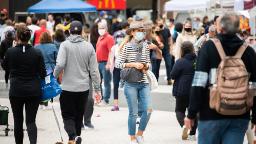
GDP report: Here’s the 2020 third quarter economy preview

Just five days before the presidential election, the Bureau of Economic Analysis will report US gross domestic product — the broadest measure of economic activity.
Economists polled by Refinitiv expect the economy expanded about 7%, when adjusted for seasonal particularities, between July and September compared to the prior three months. That would be a sharp gain from the second quarter, when the economy shrunk a seasonally-adjusted 9%.
The government typically measures quarterly GDP gains and losses on an annualized basis, which assumes the quarterly growth rate continues for a whole year. In normal times, this approach makes it easier to compare economic performance over time. But during a fast-moving crisis like the coronavirus pandemic, it makes things a little more confusing.
On an annualized and seasonally-adjusted basis, economists expect a 31% jump in the third quarter. That would be the biggest gain since the government began tracking quarterly GDP numbers in 1947. And it comes after huge losses in the second quarter, when GDP collapsed at an annualized and seasonally-adjusted rate of 31.4% — the biggest drop on record.
The partial rebound is a sign of improvement, but economists warn, it’s not as impressive as it may sound.
“The enormous contraction of GDP in the second quarter means any growth in the third quarter is coming off of a significantly smaller base of GDP,” said Josh Bivens, director of research at the Economic Policy Institute.
So the jump we will see in Thursday’s data doesn’t mean the economy is out of the woods yet — not even close. If the forecasts are right, economic activity would be about $747 billion per year below its prior peak — meaning, the recovery is far from complete.
Measuring the rebound
The US economy fell into a recession in the first half of the year.
The National Bureau of Economic Research defines a recession as a period between the peak of economic activity and the nadir. At this point, we can’t be sure that we’re out of a recession just yet. Early signs point to a slowdown in economic activity this quarter, and as Covid-19 cases spike again across America, a second lockdown — and deeper recession — are not outside the realm of possibility.
If the recession is indeed already over, the pandemic downturn would have been much shorter than the average recession, which lasted about 12 months in the post-World War II period. But this one was much deeper, said Douglas Porter, chief economist at BMO Financial Group.
Either way, the economic crisis is not over, even if Thursday’s data shows a jump in economic activity.
“The huge GDP growth it will indicate is growth off a level severely depressed by a first-ever lockdown of much of the US economy. The measure itself is meaningless,” said Daniel Alpert, senior fellow and adjunct professor of macroeconomics at Cornell Law School.
The economy is still in a far worse state than at the start of the year. Millions of people remain unemployed and rely on government benefits to make ends meet. Employers have added back only about half of the 22 million jobs lost in March and April.
“In the real world, GDP is a pretty abstract concept. Jobs and paychecks are not,” Bivens said.
Last month, an unexpectedly high number of women dropped out of the work force. Experts think that’s due to childcare responsibilities as schools are still not fully back up and running because of the pandemic.
Industries like travel and hospitality continue to struggle as people stay home more and Covid restrictions prevent business as usual. On top of all that, the virus is still spreading.
Economists are growing concerned whether the rebound will keep going in the final three months of the year, given Congress has been unable to agree on another stimulus package to get the economy back on track.















